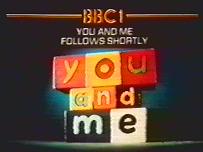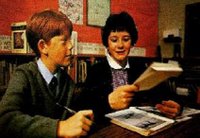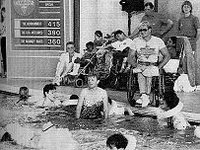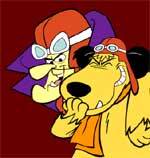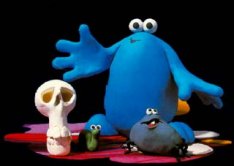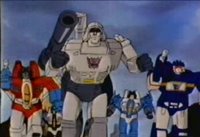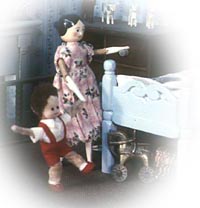 THE WIDE-AWAKE CLUB
THE WIDE-AWAKE CLUB
Made by: TVAM
Shown on: ITV
Years shown: 1985-89
Theme tune: "We're wide awake/It's good to know you're ready and you're wide awake/So on your marks and get set, go/It's Saturday, no school today, so what you gonna do?/There's no excuse to stay in bed we're waiting here for you/Oh, Wide Awake...your start/Here it is...our show/Join now, stay tuned, okay, let's go!/We're Wide Awake!"
The BBC may have had the edge with the post 9am slot, but ITV ruled the airwaves between 7.30 and nine, with this fantastic live entertainment show, presented with verve and enthusiasm, for children with the inability to lie-in. It probably saved a lot of children being strangled by their sleep-deprived parents.
The original presenting line-up saw legendary Tommy Boyd as the natural master of ceremonies; he had presented Magpie with a shocking perm, was a qualified dolphin-trainer and football referee, and mums all over the country thought he was dishy. He was always cool in a crisis, and kept a firm grip on the interviews when his celebrity subjects were getting out of hand. Then there was Arabella Warner, a slightly ‘senior’, blonde woman (very unfair, I’m sure - but she seemed old when I was eight), with big earrings; and James Baker, who just struck me as dull and not intended for children’s TV. Quite the opposite was Timmy Mallett (see WAC-a-Day), who no-one knew what to make of: and, later on in the show’s history, there was the youthful Michaela Strachan, fresh from being the ‘Her’ half of the dreadful late-night music show Hitman and Her, with Pete Waterman. James always seemed to have his arm around Michaela, in a slightly sleazy way.
There were so many features on this fast-paced show, that it’s hard to know where to start. Talent on the Telly was an opportunity for kids to come on and do an unusual party trick, such as turning their eyelids inside out, or putting a tarantula on their tongue. More often though, it was someone impersonating Frank Bruno, or doing a lame magic trick.
Still on the subject of ‘talent’, there was Singing in the Shower (later Bopping in the Bathroom), where children would stand in a fake bathroom setting, with water effects descending on them, while they sang along to Five Star or Mel and Kim.
The Bed-Making Competition was a slot where children would compete against each other to accomplish a tricky task - such as, but hardly ever, making a bed like nurses in a hospital do.
There were a couple of regular guest experts who would come on (which often signalled a good time to go and get your breakfast): Dr Pete doled out medical advice, and Philpott (probably not the name he was christened), who gave you the day’s weather predictions.
Then there was the deeply unfunny Sound Asleep Club, presented by a duo, one of whom was - incredibly enough - a youthful Canadian called Mike Myers. We all have to start somewhere, and at least nobody in his native land saw this.
Tommy took centre stage for Wac Snax, where he donned a chef’s outfit as the French-accented Didier Dodo. This was a jazzed-up cooking section, with recipes sent in by viewers but, famously, Boyd sometimes had to turn his creations down on the grounds that he was a vegetarian. That was his story, anyway.
Food was also the primary ingredient of Silly Senses, where Timmy would blindfold a child and make them taste, touch and smell various things, and then they had to guess what it was. Usually peeled grapes, tinned spaghetti or onions. Michaela and Arabella got revenge on behalf of the tormented children when they forced Timmy to bite into a clove of garlic.
A couple of slots involved viewers calling in on the phone, one of which was the curiously-named Bonk ‘n’ Boob, a quiz where George, the scoreboard, was a blatant rip-off of Dennis the Menace. Hard to picture, I know. There was also Club Call, where kids would send in the name and location of their club or society (either something genuine, like the 24th Richmond Scout Troop, or something entirely made up, such as the Winky Murder Club), and it would be pinned on a map of Great Britain.
Some sections were entirely kid-free, and were to some degree an attempt to provide a bit of educational stimulation. The WAC Newsreel was like Newsround; Fables, Parables & Miracles explained various myths and legends; and Ghosts, Monsters & Legends was a spooky story told at the wrong end of the day, but the story about the TVAM studio ghost was actually quite frightening. Just when you thought they’d finished bombarding you with information, there was Heroes & Heroines, Villains & Villainesses, and then Hero of the Day, where a viewer would nominate someone or something for having done something heroic - such as an onion preventing a goldfish going down the plughole, or a fence providing a hiding place from a swarm of bees.
Where are the celebrities?, I hear you ask. Well, they were there in force, and the Wide-Awake Club guests really captured the naffness of the eighties: see exhibits such as Nick Kamen, Kim Wilde, Spagna, Mental As Anything, Daley Thompson, Owen Paul, Swing Out Sister and Fine Young Cannibals. They were all subjected to Questions on the Cards, where Tommy would offer them a sheaf of cards, and they had to answer the questions on the cards they selected.
Mustn’t forget the cartoons, of course, which was usually the Go-Bots, a cartoon which was actually ripped off Transformers, if you can believe that. The worst thing about it was that it inspired Timmy to yell, “Go-Bots go botty!” whenever they were about to come on.
An all-time low was hit, however, with the Christmas Song competition, where children were asked to write a festive-themed song and put it to music, the best one being released as a single. The winner also had the dubious privilege of meeting the Duchess of York at the Royal Variety Performance, or something. All the short-listed songs, and the eventual winner, were performed by those spawns of Satan themselves, The Mini-Pops, in their roll-neck jumpers and patterned scarves, surrounded by fake snow and a sleigh. Talk about ruining the spirit of Christmas.
SQUARE EYES RATING: 10/10
(Thanks to www.cjetech.co.uk for the borrowed pic)
